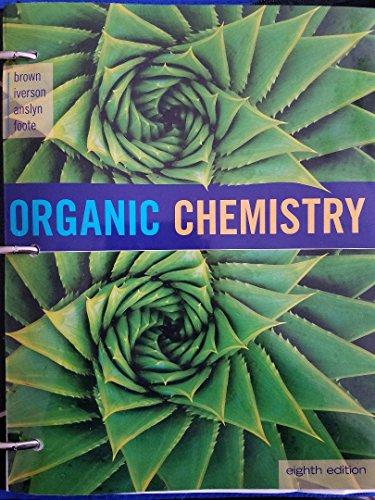
Concept explainers
Assign priorities to the groups in each set.
- (a) —H —CH3 —OH —CH2OH
- (b) —CH2CH=CH2 —CH=CH2 —CH3 —CH2COOH
- (c) —CH3 —H —COO–—NH3+
- (d) —CH3 —CH2SH —NH3+ —CHO
(a)
Interpretation:
Priorities to the given groups has to be assigned.
Concept Introduction:
Priority rules:
- Priorities based on atomic number
- When priority cannot be assigned on the basis of the atoms bonded directly to the chiral center
- Atoms participating in a double or triple bond are considered to be bonded to an equivalent number of phantom atoms.
For example,

- Priority assignment is made at the first point of difference between groups (should not be based on the larger group).
Explanation of Solution
Given groups,
Assign priorities to the given groups based on the priority rules,
(b)
Interpretation:
Priorities to the given groups has to be assigned.
Concept Introduction:
Priority rules:
- Priorities based on atomic number
- When priority cannot be assigned on the basis of the atoms bonded directly to the chiral center
- Atoms participating in a double or triple bond are considered to be bonded to an equivalent number of phantom atoms.
For example,

- Priority assignment is made at the first point of difference between groups (should not be based on the larger group).
Explanation of Solution
Given groups,
Assign priorities to the given groups based on the priority rules,
(c)
Interpretation:
Priorities to the given groups has to be assigned.
Concept Introduction:
Priority rules:
- Priorities based on atomic number
- When priority cannot be assigned on the basis of the atoms bonded directly to the chiral center
- Atoms participating in a double or triple bond are considered to be bonded to an equivalent number of phantom atoms.
For example,

- Priority assignment is made at the first point of difference between groups (should not be based on the larger group).
Explanation of Solution
Given groups,
Assign priorities to the given groups based on the priority rules,
(d)
Interpretation:
Priorities to the given groups has to be assigned.
Concept Introduction:
Priority rules:
- Priorities based on atomic number
- When priority cannot be assigned on the basis of the atoms bonded directly to the chiral center
- Atoms participating in a double or triple bond are considered to be bonded to an equivalent number of phantom atoms.
For example,

- Priority assignment is made at the first point of difference between groups (should not be based on the larger group).
Explanation of Solution
Given groups,
Assign priorities to the given groups based on the priority rules,
Want to see more full solutions like this?
Chapter 3 Solutions
Organic Chemistry, Loose-leaf Version
- for the following compounds, give their IUPAC and common names:arrow_forwardcompound CH3 CH₂0 CH3 — OH C- CH3 1 CH3-N - CH3 CH₂ ||| -C-H 01C- | NH₂ CH3 family esterarrow_forward44. Identify the class of compound for each of the following hydrocarbon derivatives. (а) CH,— ОН (c) (b) CH3-CH2-0-CH2-CH3 (d) CH,-C-NH, CH3-C-CH,-CH3 (e) (f) CH3 - -HO- CH,-C-O- (g) (h) Cl CH,-OHarrow_forward
- Calculate the number of degrees of unsaturation for each molecular formula, and propose two possible structures: (a) C8H12; (b) C10H10.arrow_forward(b) CH2CH3 H2c-c CH3 (а) NaOH CH3 MgBr (c) H3C-c-c CH2CH3 2. H30" CH3 HCI (е) (d) CH3 HCI Ether Etherarrow_forwardThe action of heating one mole of water (containing a trace of acid catalyst) on one mole of compound Y produces one mole of CH,COOH and one mole of CH, CH,NH, The structure of Y is: Select one: O CHCNCCH, CH,CH,NHCH,CH, OH CH CHNHCH,CH, O CHCH,CNHCH; O CH;CH NHÖCH;arrow_forward
- 3) Give the IUPAC names for the following structures: (a) NH2 NO2 (c) (d) C-H NH2 Br H3Carrow_forward(b) Complete the following reactions : (i) D H3C CH3 H H كما .NO2 B | Bra/Dioxane .COCH3 Aarrow_forwardfor the following compounds, Iupac name andcommon names: All questions answers needed Please answer completely will give rating surelyarrow_forward
- Citronellol ((3R)-3,7-dimethyloct-6-en-1-ol, C10H20O) is an organic fragrance found in the oil extracted from lemon grass. a) Name the two functional groups present in the molecule. b) When a few drops of bromine dissolved in hexane is added to a sample of citronellol the brown colour of the bromine rapidly disappears. i. What type of chemical reaction has occurred? ii. Draw the structure of the product formed. iii. Name the product. c) The product formed when citronellol is heated with a mixture of potassium dichromate and sulfuric acid gives a yellow/orange precipitate when shaken with Brady’s reagent (2,4-dinitrophenylhydrazine). It also shows a positive result with Fehling’s solution. i. What type of chemical reaction has occurred ? ii. What type of functional group is present in the product? d) Explain the type of stereoisomerism which may occur in citronellol.arrow_forward(a) Describe the molecular geometry expected for 1,2,3-butatriene (H2C=C=C=CH2). (b) Two stereoisomers are expected for 2,3,4-hexatriene (CH3CH=C=C=CHCH3). What should be the relationship between these two stereoisomers?arrow_forwardDraw a Lewis structure for each compound. Include all nonbonding pairs of electrons.(a) CH3COCH2CHCHCOOH (b) NCCH2COCH2CHO(c) CH2CHCH(OH)CH2CO2H (d) CH2CHC(CH3)CHCOOCH3arrow_forward
 ChemistryChemistryISBN:9781305957404Author:Steven S. Zumdahl, Susan A. Zumdahl, Donald J. DeCostePublisher:Cengage Learning
ChemistryChemistryISBN:9781305957404Author:Steven S. Zumdahl, Susan A. Zumdahl, Donald J. DeCostePublisher:Cengage Learning ChemistryChemistryISBN:9781259911156Author:Raymond Chang Dr., Jason Overby ProfessorPublisher:McGraw-Hill Education
ChemistryChemistryISBN:9781259911156Author:Raymond Chang Dr., Jason Overby ProfessorPublisher:McGraw-Hill Education Principles of Instrumental AnalysisChemistryISBN:9781305577213Author:Douglas A. Skoog, F. James Holler, Stanley R. CrouchPublisher:Cengage Learning
Principles of Instrumental AnalysisChemistryISBN:9781305577213Author:Douglas A. Skoog, F. James Holler, Stanley R. CrouchPublisher:Cengage Learning Organic ChemistryChemistryISBN:9780078021558Author:Janice Gorzynski Smith Dr.Publisher:McGraw-Hill Education
Organic ChemistryChemistryISBN:9780078021558Author:Janice Gorzynski Smith Dr.Publisher:McGraw-Hill Education Chemistry: Principles and ReactionsChemistryISBN:9781305079373Author:William L. Masterton, Cecile N. HurleyPublisher:Cengage Learning
Chemistry: Principles and ReactionsChemistryISBN:9781305079373Author:William L. Masterton, Cecile N. HurleyPublisher:Cengage Learning Elementary Principles of Chemical Processes, Bind...ChemistryISBN:9781118431221Author:Richard M. Felder, Ronald W. Rousseau, Lisa G. BullardPublisher:WILEY
Elementary Principles of Chemical Processes, Bind...ChemistryISBN:9781118431221Author:Richard M. Felder, Ronald W. Rousseau, Lisa G. BullardPublisher:WILEY





